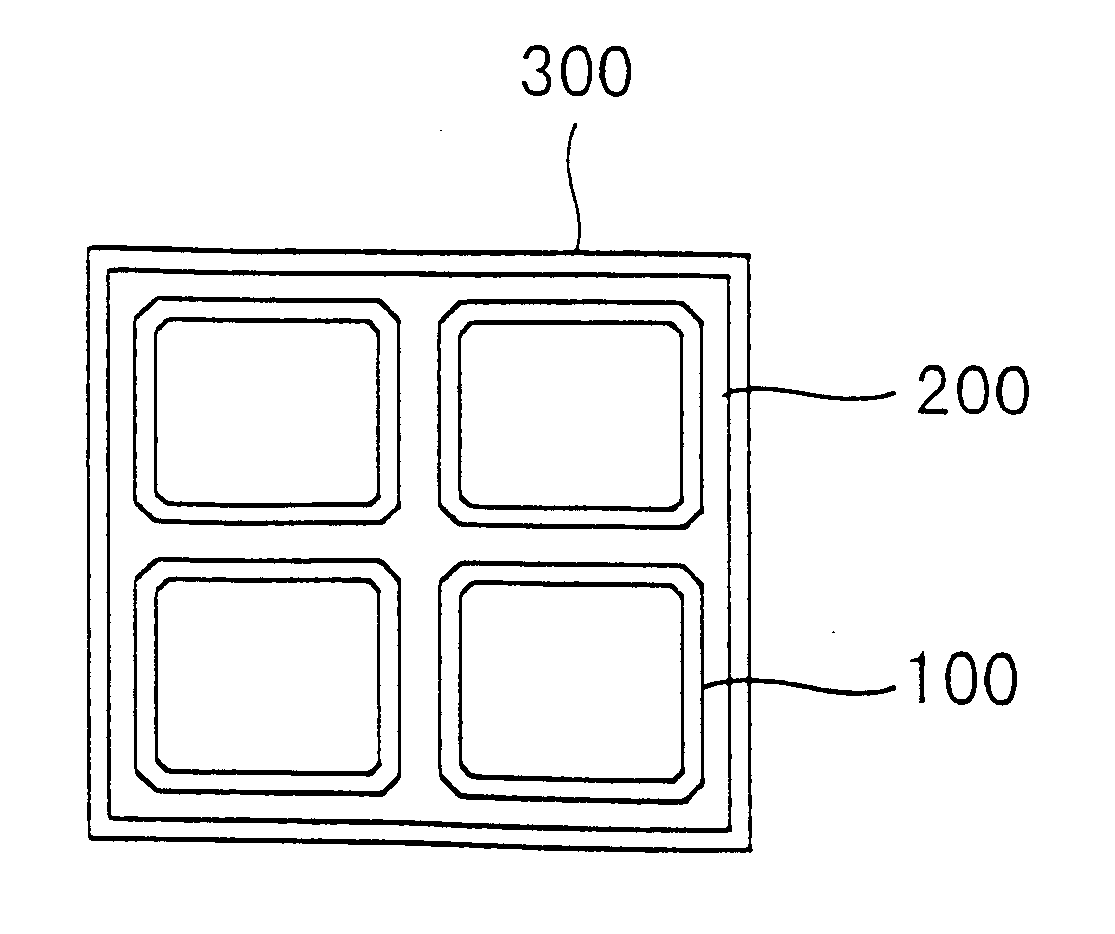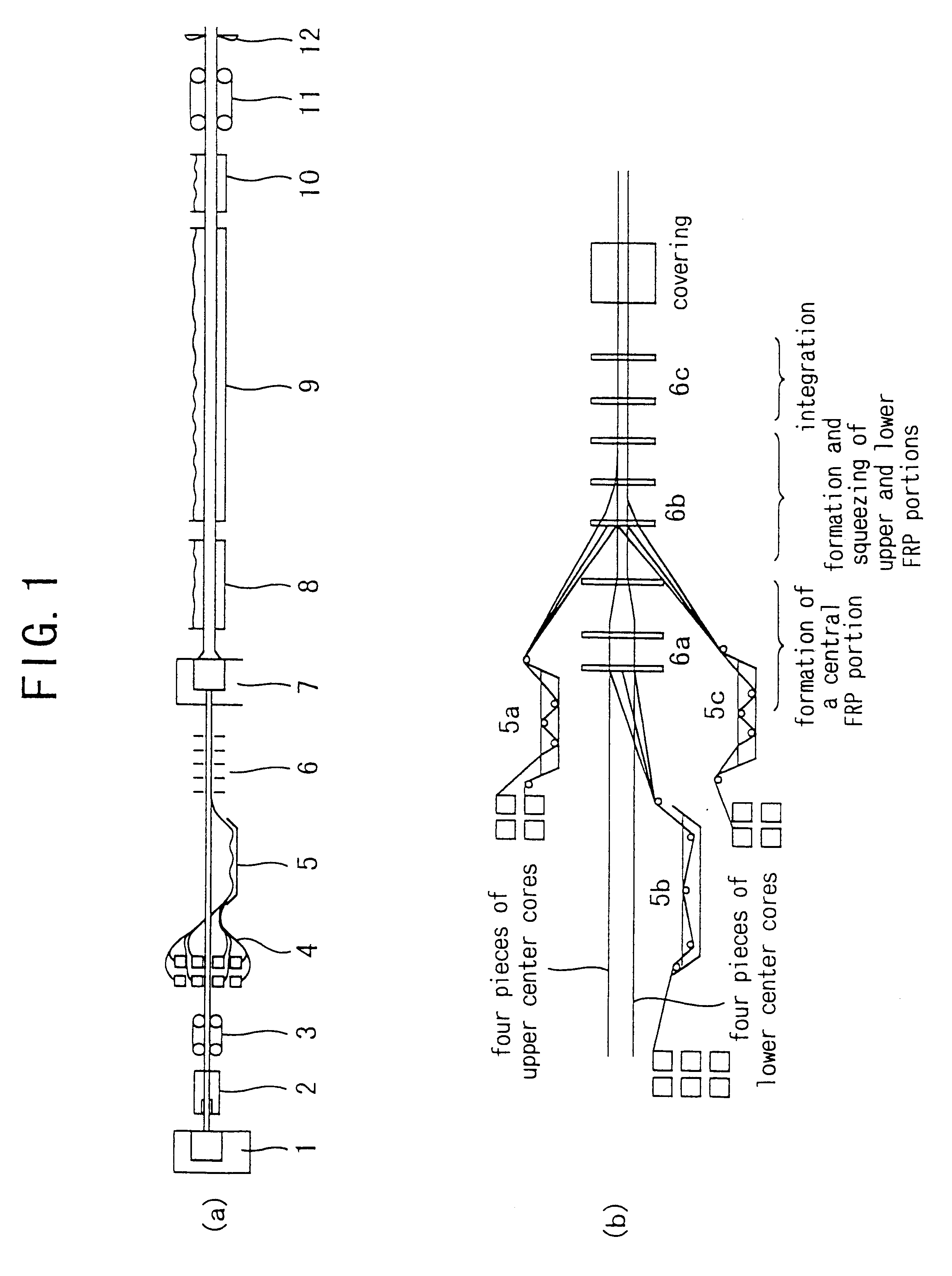In general, battens are made from steel or aluminum; however, they are heavy, and susceptible to rusting and adhesion of concrete.
When pultruding of a FRP hollow member having such a large cross-section is implemented, if the pultruding is performed using a curing die, there may occur problems such as: the die is enlarged in size and complicated in structure; a large pultruder must be employed because of the significantly increased pultruding resistance; and the die cost becomes higher because of the need of increasing the die strength.
Also, there is a problem such that the pultruding rate is as slow as 1 m / min or less.
This not only disregards the significance of the reduction in weight, but also exhibits points to be improved in terms of
resource saving and
cost efficiency, with an additional inconvenience that the dimensional accuracy of the hollow portion is insufficient.
Another problem is that if the curing temperature is higher than the
thermal deformation temperature of a
thermoplastic resin which forms the center core, the center core is liable to be softened and deformed, leading to deformation of the cross-section of the final product.
In this case, since there occurs a problem that the cross-section is liable to be deformed, the thickness of the center core is required to be further increased for suppressing this problem.
This is because when the thickness of the intermediate layer is increased,
heat generation caused by curing of FRP becomes larger, with a result that the strength of the center core is reduced and the center core is liable to be deformed.
Also the contraction caused by curing becomes larger, with a result that the side portion is liable to be deformed in a convex or concave shape.
That is to say, the
increased thickness of the intermediate layer results in larger
heat generation due to curing of FRP causing temperature rise, whereby the center core is reduced in strength and is liable to be deformed.
For a composite
pipe with the length of one side being much larger, since the above deformation becomes larger, it becomes difficult to compensate for the deformation.
A composite
pipe having a circular sectional shape is less susceptible to deformation resulting from the above reasons; however, in such a circular composite
pipe with a
diameter of a hollow portion being larger, the wall thickness of the intermediate layer is required to be increased over 10 mm to maintain the strength of the pipe, resulting in increased weight.
However, since the width thereof is over 60 mm, the above-described deformation becomes larger, to thereby reduce the strength of the material and to deteriorate stability in laminating these materials to each other upon storage and transportation.
This is because even slight deformation in the width direction tends to cause longitudinal cracks in a FRP intermediate layer because of
stress concentration, and to cause concentrated overload to be particularly applied at a central portion.
However, in this case, the rigidity in the longitudinal direction becomes low, and the manufacturing cost become high because of the increased number of manufacturing steps and the increased unit-weight.
In this composite pipe, however, if it is manufactured using a curing die, the die structure becomes more complicated and the pultruding resistance becomes significantly larger.
However, there has not been developed a method for industrially manufacturing such a composite pipe for the same reasons mentioned above.
That is to say, if the dimension of the uncured core portion is changed, the same die lip does not allow the changed dimension, and it is necessary to change the die shape upon change in dimension.
However, in the case of covering a large-sized uncured core portion having a cross-section with one side or
diameter (in cross-section) which is more than 100 mm, there arises a problem that a uniform covering cannot be obtained because of occurrence of unevenness in covering thickness and wrinkling.
More specifically, since a large-sized uncured core portion is almost always molded using a
manufacturing line installed in such a manner as to extend in the horizontal direction, molten resin tends to be drooped by the effect of gravity, which obstructs uniform covering.
Thus, if the uncured core portion has a
large size, it takes a longer time for the uncured core portion to be extrudingly-covered with the resin because the pultruding rate becomes slow.
As a result, the resin is excessively cooled and is not sufficiently drafted.
This causes wrinkling of the covering layer and cavities between the covering layer and the uncured core portion.
Additionally, a difference in
cooling rate between two locations causes unevenness of covering thickness therebetween.
The reason to such unevenness by cooling is that environmental air is heated by the uncured core portion extruded from the die, and this causes
convection.
This causes unevenness in temperature at the covering points, thereby making it difficult to uniformly cover the uncured core portion.
These methods are disadvantageous in that it is difficult to ensure a uniform covering thickness because of the presence of seams (overlapped edge portions) of the resin sheet.
In each case, however, there occurs another problem that marks of such post-treatments are liable to remain.
For a large-sized composite hollow structure having one side (width) of more than 100 mm (
peripheral length: 200 mm or more), there may arise an inconvenience that rippling
waves-like wrinkles occur on the surface because of the increased sizing resistance.
Additionally, only a
slight change in dimension (outer shape) of a composite hollow structure brought about by change in condition may cause the structure to be stopped in the sizing device.
This makes it impossible, in the worst case, to pultrude the composite hollow structure.
In the water-cooled sliding type sizing, if the covering thickness is uneven and / or foreign materials appear on the surface, the sealing-state of water between the composite hollow structure and the sizing device may be broken.
This may leading to occurrence of water running, and irregularities may appear on the surface of the uneven portion because the
cooling rate of this portion is different from those of the surroundings.
Once water running starts, such running is expanded, and finally there arises a problem that water is scattered to the covering die, to make it impossible to continue the molding.
For a large-sized composite hollow structure having one side of more than 100 mm, since the manufacturing speed (pultruding speed) becomes naturally slow, it is difficult to prevent water from running to the side of the covering die with
viscosity of water caused between the surface of the sizing surface and the composite hollow structure.
The sizing apparatus has no flexibility to adapt to the varied dimension of a composite hollow structure being subjected to sizing.
That is to say, the set of sizing devices, which are not commonly used for composite hollow structures different in width, thickness and the like, are poor
in degree of freedom of
usability.
However, as the temperature of the resin becomes high, the shape retention characteristic thereof becomes low (the
thermal deformation temperature of the general ABS resin is about 90.degree. C. or less), causing the tendency that the sectional shape of the composite hollow structure is changed.
Since the composite hollow structure is cured in hot water, the structure, particularly, having a large-size is applied with large
buoyancy, and thereby it is liable to be deformed (warped) in the longitudinal direction.
However, warping may occur in the width direction (deformation of the sectional shape, which projects downward or is recessed upward).
In this case, the composite hollow structure of a three-layer structure including a center core made from
thermoplastic resin, an intermediate layer made from FRP, and an outer cover layer made from thermoplastic resin exhibits an inconvenience that the smooth outer cover layer becomes slippery when it gets wet.
Also, in case a
powder-like material, such as sand or other such material, adheres to the covering layer, it tends to get slippery.
(5) When used as a
scaffold board for various works, a fiber-reinforced composite hollow structure may possibly fall or collide into a wall or the ground during transportation, or comes in contact with other
scaffold boards in use, so that the
impact force applied to the structure may cause cracks in the FRP-made intermediate layer of the structure at its end portion.
The progress of these cracks leads to longitudinal cracks in the intermediate layer and reduction in strength and rigidity of the structure, thereby making, in the worst case, it impossible to the continue use of the structure.
On the other hand, provision of a
metal-made protective member on the end portion of a composite hollow structure cause a problem in terms of electric insulation and
corrosion resistance.
However, since a composite hollow structure of the present invention is generally long in length and has a continuous hollow portion, insert-molding of resin cannot be applied.
However, in this case,
permeation of water into the hollow portion cannot be fully prevented because the
adhesive cannot be fully applied around the portion of the cap to be fitted to the hollow portion, and even if the
adhesive is fully applied, there is a possibility of partial leakage of water after a long-term use.
In the case of using a hermetic-type cap, if water is accumulated in the hollow portion of the center core, it cannot be easily removed, which may degrade the electric characteristics and safety of the structure.
This will certainly complicate the mounting work of the caps.
Further, if there are differences and / or inclinations among the hollow portions, the adjacent caps may be in contact with each other, thus making it, in the worst case, impossible to
mount the caps.
Even in the case of using an integral-type cap structure in which seven pieces of projections as plugs are integrally juxtaposed, there is a fear that the projections cannot be inserted into the hollow portions unless they exhibit a deformation function.
If the caps are not deformable and if the projections are designed to be small in consideration of dimensional tolerances of the composite hollow structure, there is a fear that the projections will float and will not be brought into contact with the walls of the hollow portions of the composite hollow structure.
In this case, there is a fear that the projections tend to fall off from the hollow portions.
Even if the number of the projections is reduced, and only three projections are provided correspondingly to the right, left and central hollow portions, the above problem cannot be solved.
As a result, the cap is possibly loosened upon transportation because the composite hollow structure will get caught to each another.
Also, the composite hollow structures are usually stacked upon transportation or storage, but the workability will become poor, and the stacks will tilt and consequently collapse because of the presence of the step portions.
 Login to View More
Login to View More 


